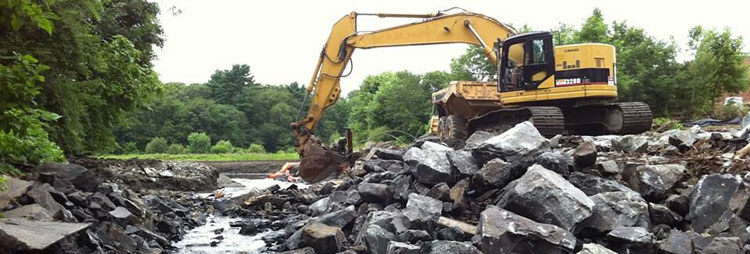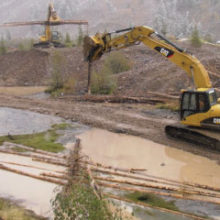- The U.S. has more than 87,000 dams greater than six feet high (and two million overall). While many dams continue to provide benefits such as flood control, irrigation, and water supply, for other dams the cost of maintenance or the negative effects on communities, fish, and tribes justifies their removal.
- Dam owners and regulators decide whether to remove a dam by weighing many factors including: the cost of removal and the ability to replace any lost power generation against avoided long-term maintenance; safety concerns; benefits to endangered fish populations; increased recreational and commercial fishing; and restoration of cultural values of nearby tribes.
- By 2020, roughly 70% of dams will be more than 50 years old, inviting us to reconsider the value to the public of long-term investments in this infrastructure.
This report describes the methods used to measure the benefits of dam removal when comparing costs to benefits, including five case studies and a summary of small dams. The case studies illustrate the range of benefits and costs that can be considered, multiple methodological approaches, and a range of locations.
We also provide an Executive Summary which includes background, measuring the benefits of dam removal, summary table, and conclusion.

Since the 18th century, dams have been built across the United States to power mills, provide downstream flood control, facilitate transportation, provide irrigation water, and generate hydroelectricity. Presently there are more than two million dams across the country, 87,000 of which are more than six feet tall.
Over time these dams have aged. By 2020, 70% of dams in the U.S. will be more than 50 years old. The Association of State Dam Safety Officials—a national non-profit serving state dam safety programs—estimates it could cost $51.5 billion to rehabilitate the nation’s non-federally owned dams.
While some dams continue to serve useful purposes, others have outlived their original function. For these obsolete dams, the benefits to the public of removing them outweighs the costs.
Since 1912, more than 1,300 dams have been removed across the U.S., and 62 dams were removed in 2015 alone.
The case studies range from small former mill sites to large Western hydropower dams, including:
- Whittenton Pond Dam on the Mill River in Massachusetts;
- Elwha and Glines Canyon Dams on the Elwha River in Washington;
- Edwards Dam on the Kennebec River in Maine;
- Condit Dam on the White Salmon River in Washington;
- Great Works and Veazie Dams on the Penobscot River in Maine; and
- Three small dam removals including Hyde Pond Dam on Whitford Brook in Connecticut, Bartlett Pond Dam on Wekepeke Brook in Massachusetts, and White Rock Dam on Pawcatuck River in Connecticut and Rhode Island.
Subscribe to our newsletter!
Measuring the Benefits of Dam Removal
This section briefly summarizes benefits discussed in more detail in the full report.
Cost-Effectiveness of Maintenance Versus Removal
Dams require ongoing maintenance to remove accumulating sediment, make small repairs, and upgrade safety systems. Particularly when older dams are no longer used for their original purpose, dam owners may defer maintenance to the point where the dams pose a threat to public safety.
In these cases, it is appropriate for dam owners to work with state and federal experts to figure out how to protect communities. In some cases, it is less expensive to remove the dam than to make the necessary repairs.
Vulnerable Species and Other Environmental Benefits
Dams interfere with the life cycle of migratory fish by blocking the migration of adults to upstream spawning grounds, as well as limiting the passage of sediment and large woody debris necessary to maintain suitable spawning areas downstream.
Follow-up population studies after dam removal have found that species quickly return to upstream spawning habitat, even when the river has been blocked for 100 years.
Cultural Values
In addition to subsistence and commercial fish harvests, many Native American tribes have deep cultural, spiritual, and historical connections to specific free flowing rivers, features along those rivers, and the animal and plant species they support.
Recreational and Commercial Fisheries
Removing dams also can increase the abundance of commercially and recreationally targeted fish species. Benefits to commercial fisheries are measured in terms of increased revenue from improved catch rates while benefits to recreational anglers are measured in terms of improved experiences and in terms of additional jobs and income supported by more visiting anglers.
River Recreation and Other Tourism
Removing dams and returning rivers to a free-flowing state can provide new boating opportunities, particularly for whitewater rafting, canoeing, and kayaking. Neighboring communities benefit from increased whitewater recreation and other river-related tourism when visitors spend money with local guides, outfitters, restaurants, and other businesses, bringing new money to oftentimes remote communities.
Non-Market Values
People value seemingly unquantifiable outdoor amenities like free-flowing rivers, endangered species, and recreational opportunities. Researchers are able to apply statistical methods to measure how much people value selected environmental qualities and then translate that value into dollars. These “non-market values” can then be incorporated into cost-benefit analyses.
Researchers have found that people place substantial value on the following environmental changes associated with removing dams:
- The existence of a free-flowing river that individuals can see now or in the future, or will be available for their children to visit;
- Knowledge that endangered species are present in a river and their population is recovering;
- Improved catch rates for recreational anglers; and
- Improved experiences for whitewater boaters.
Non-market benefits are distinct from the additional spending that anglers and tourists bring to an area. Because the benefits are experienced by people close to the dam as well as those who live far away, total non-market benefits can be quite large and therefore influential in dam relicensing decisions.
Cost-Effectiveness of Energy Production
Many older hydroelectric dams were built to support nearby mills, factories, and communities, and have relatively small generating capacity. As the U.S. power grid has shifted to more regional rather than local production, power produced by smaller dams can be more expensive than power from regional sources or may no longer be needed if the nearby industrial user has closed.
Economic Impact of Removal Projects
Dam removal and associated river restoration can be substantial, multi-year projects, employing local residents, providing personal income, and contributing to the local economy. Jobs associated with these removal projects often are relatively short-term, but nonetheless valuable particularly in smaller communities.
Property Values
Researchers have found that some dams, particularly small dams with small upstream impoundments, can create an unpleasant feature that drives down property values due to lower water quality or flooding risk.
Conclusion: Dam Removal Case Studies
Dam removal decisions are complex, requiring owners and regulators to weigh a dam’s current value in accomplishing its original purpose—such as flood control, agriculture, recreation, and power generation—against the dam’s ongoing effects on public safety, water quality, fish and other species, recreation, and cultural values. These considerations also must be evaluated in the context of long-term maintenance costs and costs of removal.
As the thousands of dams in the U.S. have aged, the upkeep expenses and the need for significant repairs has risen for many dams. At the same time, scientific research has improved our understanding of river systems and the effects dams have on a region’s environmental health. Advances in economic methods also have improved our understanding of the economic benefits to nearby communities, river users, and the broader public from free-flowing rivers.
Together, the higher ongoing costs of operating dams and an improved awareness of the economic and social benefits of removing them has shifted the balance sheet for some dams. For these dams, removal often provides greater rewards to taxpayers, local economies, and the surrounding environment. Additionally, funding for removal projects often can be gathered from several sources as different agencies, organizations, and communities better understand how they can benefit from dam removal.
The case studies in this report highlight the many factors that contribute to dam removal decisions, how these factors have been weighed, and the process that led to a dam’s removal. This review demonstrates that in many cases the economic, environmental, and social benefits of dam removal outweigh the costs of keeping a dam in place.





